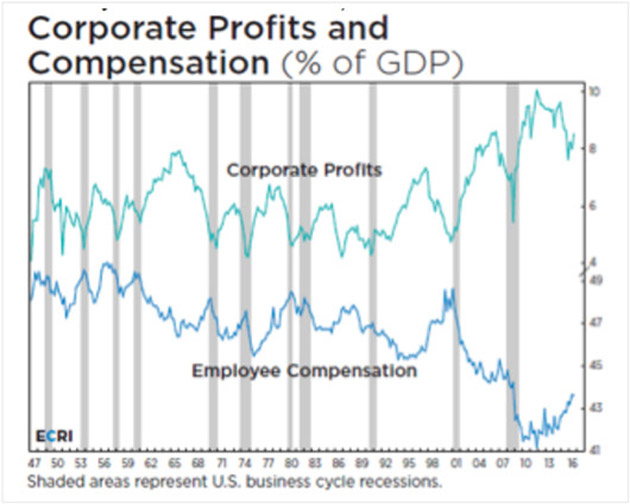While the economy continues to grow and worker production increases, the wages have stagnated or declined. This has been of concern to economists. A recent article by Tepper has some stats, if not explanations. (an important distinction.)

Disconnect between productivity and typical worker’s compensation

(Source: Economic Cycle Research Institute)
American company profits are certainly up. But much of the profits have gone to stock buybacks or dividends, earnings and stock prices often being connected to executive pay.
Another explanation is the growth of monopolies.
Two corporations control 90% of the beer Americans drink.
When it comes to high-speed internet access, almost all markets are local monopolies; over 75 percent of households have no choice with only one provider.
Four airlines completely dominate airline traffic, often enjoying local monopolies or duopolies in their regional hubs. Five banks control about half of the nation’s banking assets.
Many states have health insurance markets where the top two insurers have 80-90% market share. For example, in Alabama one company has 84% market share and in Hawaii one has 65% market share.
Four players control the entire US beef market.
After two mergers this year, three companies will control 70 percent of the world’s pesticide market and 80 percent of the US corn-seed market.
(Source: Pine Capital)
Over half of all public firms have disappeared over the last twenty years. There is a virtual a collapse of publicly listed companies. Astonishingly, according to a study by Credit Suisse, “between 1996 and 2016, the number of publicly-listed stocks in the U.S. fell by roughly 50% from more than 7,300 to fewer than 3,600 while rising by about 50% in other developed nations.” It is not lower growth or the global Financial Crisis that caused fewer IPOs. This is distinctly an American phenomenon.
The decline in listed companies has been so spectacular that the number lower is than it was in the early 1970s, when the real GDP in the US was just one third of what it is today. America’s economy grows ever year, but the number of listed companies shrinks. On this trend, by 2070 we will only have one company per industry.
Another is the decline in farm pay, influenced also by dominance of rural areas by a single industry or company.
In 1980, if you lived in Washington D.C., your per-capita income was 29 percent above the average American; in 2013 you would be 68 percent above. In New York City, the income was 80 percent above the national average in 1980 and skyrocketed to 172 percent above by 2013
No comments:
Post a Comment